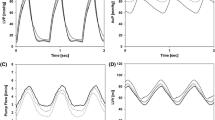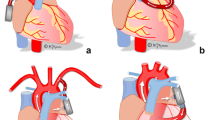Abstract
Mechanical circulatory support devices (MCSDs) have gained widespread clinical acceptance as an effective heart failure (HF) therapy. The concept of harnessing the kinetic energy (KE) available in the forward aortic flow (AOF) is proposed as a novel control strategy to further increase the cardiac output (CO) provided by MCSDs. A complete mathematical development of the proposed theory and its application to an example MCSDs (two-segment extra-aortic cuff) are presented. To achieve improved device performance and physiologic benefit, the example MCSD timing is regulated to maximize the forward AOF KE and minimize retrograde flow. The proof-of-concept was tested to provide support with and without KE control in a computational HF model over a wide range of HF test conditions. The simulation predicted increased stroke volume (SV) by 20% (9 mL), CO by 23% (0.50 L/min), left ventricle ejection fraction (LVEF) by 23%, and diastolic coronary artery flow (CAF) by 55% (3 mL) in severe HF at a heart rate (HR) of 60 beats per minute (BPM) during counterpulsation (CP) support with KE control. The proposed KE control concept may improve performance of other MCSDs to further enhance their potential clinical benefits, which warrants further investigation. The next step is to investigate various assist technologies and determine where this concept is best applied. Then bench-test the combination of kinetic energy optimization and its associated technology choice and finally test the combination in animals.















Similar content being viewed by others
References
Abraham, W. T., S. Aggarwal, S. D. Prabhu, R. Cecere, S. V. Pamboukian, A. J. Bank, B. Sun, W. E. Pae, C. S. Hayward, P. M. McCarthy, and W. S. Peters. Ambulatory extra-aortic counterpulsation in patients with moderate to severe chronic heart failure. JACC 2(5):526–533, 2014.
Applebaum, R. M., H. H. Wun, E. S. Katz, P. A. Tunick, and I. Kronzon. Effects of intraaortic balloon counterpulsation on carotid artery blood flow. Am. Heart J. 135(5):850–854, 1998.
Breitenstein D. S. Cardiovascular Modeling: The Mathematical Expression of Blood Circulation. Master’s thesis, University of Pittsburgh, PA, 1993.
Cheng, A., G. Monreal, M. L. William, I. I. Michael Sobieski, and M. S. Slaughter. Extended extra-aortic counterpulsation with the C-pulse device does not alter aortic wall structure. ASAIO J. 60(6):5–7, 2014.
Giridharan, G. A., C. R. Bartoli, P. A. Spence, R. D. Dowling, and S. C. Koenig. Counterpulsation with symphony prevents retrograde carotid, aortic, and coronary flows observed with intra-aortic balloon pump support. Artif. Organ. 36(7):600–606, 2012.
Hunt, S. A., W. T. Abraham, M. H. Chin, A. M. Feldman, G. S. Francis, T. G. Ganiats, M. Jessup, M. A. Konstam, D. M. Mancini, K. Michl, and J. A. Oates. ACC/AHA 2005 guideline update for the diagnosis and management of chronic heart failure in the adult a report of the American College of Cardiology/American Heart Association Task Force on Practice Guidelines (Writing Committee to Update the 2001 Guidelines for the Evaluation and Management of Heart Failure): developed in collaboration with the American College of Chest Physicians and the International Society for Heart and Lung Transplantation: endorsed by the Heart Rhythm Society. Circulation. 112(12):e154–e235, 2005.
Koenig, S. C., P. A. Spence, G. M. Pantalos, R. D. Dowling, and K. N. Litwak. Development and early testing of a simple subcutaneous counterpulsation device. ASAIO J. 52(4):362–367, 2006.
Legget, M. E., W. S. Peters, F. P. Milsom, J. S. Clark, T. M. West, R. L. French, and A. F. Merry. Extra-aortic balloon counterpulsation an intraoperative feasibility study. Circulation 112(9 suppl):I–26, 2005.
Mitnovetski, S., A. A. Almeida, A. Barr, W. S. Peters, F. P. Milsom, B. Ho, and J. A. Smith. Extra-aortic implantable counterpulsation pump in chronic heart failure. Ann. Thorac. Surg. 85(6):2122–2125, 2008.
Nakatani, S., S. Beppu, S. Nagata, F. Ishikura, J. Tamai, M. Yamagishi, F. Ohmori, K. Kimura, M. Takamiya, and K. Miyatake. Diastolic suction in the human ventricle: observation during balloon mitral valvuloplasty with a single balloon. Am. Heart J. 127(1):143–147, 1994.
Randall, D., W. W. Burggren, K. French, and R. Eckert. Eckert Animal Physiology. Macmillan, 2002.
Schulz, A., T. Krabatsch, J. D. Schmitto, R. Hetzer, M. Seidel, P. M. Dohmen, and H. Hotz. Preliminary results from the C-Pulse® OPTIONS HF European Multicenter post-market study. Med. Sci. Monit. Basic Res. 22:14–19, 2016.
Simaan, M. A., A. Ferreira, S. Chen, J. F. Antaki, and D. G. Galati. A dynamical state space representation and performance analysis of a feedback-controlled rotary left ventricular assist device. IEEE Trans. Control Syst. Technol. 17(1):15–28, 2009.
Solanki, P. Aortic counterpulsation: C-pulse and other devices for cardiac support. J. Cardiovasc. Transl. Res. 7(3):292–300, 2014.
Tortora, G. J. and B. H. Derrickson. Principles of Anatomy & Physiology. The Cardiovascular System: Blood Vessels and Hemodynamics, 13th ed. Wiley, 2012.
Wang, Y., and M. A. Simaan. A new method for detecting aortic valve dynamics during control of the rotary Left Ventricular Assist Device support. Am. Control Conf. 2014:5471–5476, 2014.
Wu, Y., P. Allaire, G. Tao, and S. T. Lim. Passive and active ventricular elastances of the left ventricle. Biomed. Eng. Online 4(1):1, 2005.
Yotti, R., B. Javier, and J. C. Antoranz. A noninvasive method for assessing impaired diastolic suction in patients with dilated cardiomyopathy. Circulation 112(19):2921–2929, 2005.
Yu, Y. C. Minimally Invasive Estimation of Cardiovascular Parameters. Doctoral dissertation, Ph. D. thesis, Univ. Pittsburgh, PA. 1998.
Yu, Y. C., J. R. Boston, M. A. Simaan, and J. F. Antaki. Estimation of systemic vascular bed parameters for artificial heart control. IEEE Trans. Autom. Control 43(6):765–778, 1998.
Zhong, L., D. N. Ghista, E. Y. Ng, and S. T. Lim. Passive and active ventricular elastances of the left ventricle. Biomed. Eng. Online 4(1):1, 2005.
Author information
Authors and Affiliations
Corresponding author
Ethics declarations
Conflict of interest
Muhammad B. Qureshi, Jacob Glower, Daniel L. Ewert and Steven C. Koenig declare that they have no conflict of interest.
Ethical Approval
No human and animal studies were carried out by the authors for this article.
Additional information
Associate Editor John Timothy Baldwin and Ajit P. Yoganathan oversaw the review of this article.
Rights and permissions
About this article
Cite this article
Qureshi, M.B., Glower, J., Ewert, D.L. et al. A Novel Idea to Improve Cardiac Output of Mechanical Circulatory Support Devices by Optimizing Kinetic Energy Transfer Available in Forward Moving Aortic Blood Flow. Cardiovasc Eng Tech 8, 131–144 (2017). https://doi.org/10.1007/s13239-017-0305-2
Received:
Accepted:
Published:
Issue Date:
DOI: https://doi.org/10.1007/s13239-017-0305-2




